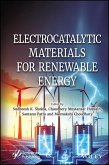Materials and Thermodynamics (eBook, PDF)


Alle Infos zum eBook verschenken

Materials and Thermodynamics (eBook, PDF)
- Format: PDF
- Merkliste
- Auf die Merkliste
- Bewerten Bewerten
- Teilen
- Produkt teilen
- Produkterinnerung
- Produkterinnerung

Hier können Sie sich einloggen

Bitte loggen Sie sich zunächst in Ihr Kundenkonto ein oder registrieren Sie sich bei bücher.de, um das eBook-Abo tolino select nutzen zu können.
A thermodynamic system is defined according to its environment and its compliance. This book promotes the classification of materials from generalized thermodynamics outside the equilibrium state and not solely according to their chemical origin. The author goes beyond standard classification of materials and extends it to take into account the living, ecological, economic and financial systems in which they exist: all these systems can be classified according to their deviation from an ideal situation of thermodynamic equilibrium. The concepts of dynamic complexity and hierarchy, emphasizing…mehr
- Geräte: PC
- mit Kopierschutz
- eBook Hilfe
- Größe: 30.28MB
![The Advanced Materials Revolution (eBook, PDF) The Advanced Materials Revolution (eBook, PDF)]() Sanford L. MoskowitzThe Advanced Materials Revolution (eBook, PDF)88,99 €
Sanford L. MoskowitzThe Advanced Materials Revolution (eBook, PDF)88,99 €![Materials Science and Technology of Optical Fabrication (eBook, PDF) Materials Science and Technology of Optical Fabrication (eBook, PDF)]() Tayyab I. SuratwalaMaterials Science and Technology of Optical Fabrication (eBook, PDF)131,99 €
Tayyab I. SuratwalaMaterials Science and Technology of Optical Fabrication (eBook, PDF)131,99 €![Zinc Oxide Materials for Electronic and Optoelectronic Device Applications (eBook, PDF) Zinc Oxide Materials for Electronic and Optoelectronic Device Applications (eBook, PDF)]() Zinc Oxide Materials for Electronic and Optoelectronic Device Applications (eBook, PDF)162,99 €
Zinc Oxide Materials for Electronic and Optoelectronic Device Applications (eBook, PDF)162,99 €![Thermal Properties Measurement of Materials (eBook, PDF) Thermal Properties Measurement of Materials (eBook, PDF)]() Yves JannotThermal Properties Measurement of Materials (eBook, PDF)139,99 €
Yves JannotThermal Properties Measurement of Materials (eBook, PDF)139,99 €![Artificial Materials (eBook, PDF) Artificial Materials (eBook, PDF)]() O. VanbésienArtificial Materials (eBook, PDF)168,99 €
O. VanbésienArtificial Materials (eBook, PDF)168,99 €![Electrocatalytic Materials for Renewable Energy (eBook, PDF) Electrocatalytic Materials for Renewable Energy (eBook, PDF)]() Electrocatalytic Materials for Renewable Energy (eBook, PDF)173,99 €
Electrocatalytic Materials for Renewable Energy (eBook, PDF)173,99 €![Advanced Coating Materials (eBook, PDF) Advanced Coating Materials (eBook, PDF)]() Advanced Coating Materials (eBook, PDF)197,99 €
Advanced Coating Materials (eBook, PDF)197,99 €-
-
-
Dieser Download kann aus rechtlichen Gründen nur mit Rechnungsadresse in A, B, BG, CY, CZ, D, DK, EW, E, FIN, F, GR, HR, H, IRL, I, LT, L, LR, M, NL, PL, P, R, S, SLO, SK ausgeliefert werden.
- Produktdetails
- Verlag: John Wiley & Sons
- Seitenzahl: 304
- Erscheinungstermin: 14. August 2017
- Englisch
- ISBN-13: 9781119427971
- Artikelnr.: 52554289
- Verlag: John Wiley & Sons
- Seitenzahl: 304
- Erscheinungstermin: 14. August 2017
- Englisch
- ISBN-13: 9781119427971
- Artikelnr.: 52554289
- Herstellerkennzeichnung Die Herstellerinformationen sind derzeit nicht verfügbar.
Introduction xiii
Chapter 1 Form and Matter: The Genesis of Materials 1
1.1 Role and evolution of geometric shapes in chemistry 2
1.1.1 Shape and matter: the origins 2
1.1.2 From the Renaissance to modern chemistry 4
1.1.3 Modern era 6
1.2 Contributions of complexity of forms and thermodynamics 9
1.2.1 Development of more complex forms 9
1.2.2 Introduction to generalized thermodynamics 11
1.2.3 Toward a classification of materials 13
1.3 Perspectives 14
Chapter 2 Thermodynamics of Condensed Matter 15
2.1 Definitions in thermodynamics 16
2.1.1 Concept of a thermodynamic system 16
2.1.2 Review of thermodynamic equilibrium states 17
2.1.3 Energy transformations and efficiency 20
2.1.4 Systems without thermodynamic equilibrium 23
2.2 Examples of hardware systems 26
2.2.1 Responses close to equilibrium 27
2.2.2 Responses far from equilibrium 29
2.2.3 Role of chemical reactors 33
2.3 Material development and characterization 36
2.3.1 Situation close to equilibrium: crystallogenesis 36
2.3.2 Situation far from equilibrium: morphogenesis 40
2.3.3 Production processes 43
2.4 Conclusion 43
Chapter 3 Classification of Materials 45
3.1 Role of surfaces and interfaces 46
3.1.1 Nature and symmetry of a phase separation 46
3.1.2 Classification according to the requirements 47
3.1.3 Composition of a system 47
3.1.4 Type of responses and functionality 49
3.2 Main types of materials and systems 50
3.2.1 Structural materials 50
3.2.2 Electronic operators and transmitters 53
3.2.3 Optical devices 58
3.2.4 Adsorbers and chemical sensors 64
3.2.5 Actuators and their analogues 69
3.3 Conclusion 69
Chapter 4 Materials and Devices for Energy and Information 71
4.1 Conversion and storage of electrical energy 71
4.1.1 Direct conversion electric generators 72
4.1.2 Indirect production and use of electricity 80
4.1.3 Storage of energy 83
4.2 Recording and storing information 85
4.2.1 Main features 86
4.2.2 Main types of memories 87
4.3 Conclusion 92
Chapter 5 Microscopic Models and Statistical Thermodynamics 95
5.1 Typical microscopic models 95
5.1.1 Law of distribution and definition of statistical entropy 96
5.1.2 Thermodynamic systems and canonical ensembles 97
5.1.3 Situations beyond equilibrium 98
5.1.4 Stochastic thermodynamics 100
5.2 Quantum statistics 101
5.2.1 Review of concepts 101
5.2.2 Quantum distribution laws 101
5.2.3 Elementary excitations and quantum particles in solids 103
5.3 Information theory 105
5.3.1 Shannon-Brillouin model 105
5.3.2 Energy and information: the Landauer principle 106
5.3.3 The role of quantum mechanics 108
5.3.4 Remarks on the notion of information and the concept of entropy 110
5.4 Conclusion 112
Chapter 6 Nanomaterials 113
6.1 The new classes of materials 113
6.1.1 Conjugate conductive polymers 114
6.1.2 Charge transfer salts and complexes 115
6.1.3 Molecular carbonaceous phases 116
6.1.4 Other nanomaterials 118
6.2 Nanometric assemblies and manipulations 118
6.2.1 Thin film techniques and imposed structures 119
6.2.2 Supramolecular chemistry and the colloidal approach 120
6.2.3 Nanowires and nanocomposites 123
6.2.4 Detection and manipulation of particles 124
6.2.5 Molecular recognition, nanosensors and actuators 126
6.3 Conclusion 128
Chapter 7 Engineering and Molecular Electronics 129
7.1 Nanotechnologies 129
7.1.1 Nanoelectronics 129
7.1.2 Nanophotonics 133
7.1.3 Nanomagnetism 138
7.1.4 Nanomachines 141
7.2 Memory and quantum logic 143
7.2.1 Quantum phenomena 143
7.2.2 Experimental devices 144
7.2.3 Information, thermodynamics and quantum chaos 147
7.3 State of the art: nanomaterials and quantum electronics 148
Chapter 8 Living World, Biomaterials and Biosystems 149
8.1 Living systems and energy balances 150
8.1.1 On the definition of the living world 150
8.1.2 Thermodynamic model 152
8.1.3 Conversion and storage of energy 154
8.1.4 Operation of a cell reactor 158
8.2 Biomaterials and biosystems 158
8.2.1 Morphogenesis and biomimicry 159
8.2.2 Biodetectors and similar functions 162
8.2.3 Bioconverters and natural energy sources 165
8.2.4 Engines, receptors and bionic robots 170
8.2.5 Bioinformatics 171
8.2.6 Biosynthesis 174
8.3 Conclusion 175
Chapter 9 Extensions to Living Organisms and Ecology 177
9.1 Behavior of cells and organs 178
9.1.1 Biochemical oscillations and biological rhythms 178
9.1.2 Spatiotemporal organizations and Turing structures 180
9.1.3 Rhythms and chaos in certain organs 182
9.1.4 Neural networks, information and cognitive behavior 183
9.2 Physiology of a living organism 187
9.2.1 Thermodynamic system and metabolism 187
9.2.2 Collective behavior 189
9.3 Ecosystems and natural cycles 190
9.3.1 The predator-prey relationship 191
9.3.2 Grand natural cycles 193
9.3.3 Climate models 194
9.4 Conclusion 196
Chapter 10 Application of Thermodynamics to Economy 199
10.1 Thermodynamic models of economy 200
10.1.1 Chronology of energy models 200
10.1.2 Analysis of fundamental concepts 205
10.2 Dynamics of economic and financial systems 209
10.2.1 Economic cycles 209
10.2.2 Analysis of financial fluctuations 210
10.2.3 Stock market crashes 211
10.2.4 Statistical modeling of financial systems 212
10.2.5 On the behavior of a financial system 214
10.3 Conclusion 215
Chapter 11 From Thermodynamic Systems to Complex Systems 217
11.1 Thermodynamic models: from energy to entropy 218
11.1.1 Modeling of a thermodynamic system 218
11.1.2 Entropy and information 221
11.2 Classification of materials and devices 224
11.2.1 Functional advanced materials 224
11.2.2 Nanomaterials and quantum mechanics 225
11.2.3 Biomaterials inspired by living environments 226
11.2.4 Extension to living organisms, ecological and economic systems 227
11.3 Rhythms, complexity and synergy of dynamic systems 228
11.3.1 From the analysis of shape to functionality 228
11.3.2 Scale analysis and organizational hierarchy 229
11.3.3 Constraints and flows: characteristic oscillations and cycles 230
11.3.4 Dynamic and cybernetic systems 231
11.3.5 Toward a definition of complex systems 233
11.4 Epilogue: descriptive uniqueness and limitation of thermodynamic bases
235
Glossary 237
Bibliography 243
Index 267
Introduction xiii
Chapter 1 Form and Matter: The Genesis of Materials 1
1.1 Role and evolution of geometric shapes in chemistry 2
1.1.1 Shape and matter: the origins 2
1.1.2 From the Renaissance to modern chemistry 4
1.1.3 Modern era 6
1.2 Contributions of complexity of forms and thermodynamics 9
1.2.1 Development of more complex forms 9
1.2.2 Introduction to generalized thermodynamics 11
1.2.3 Toward a classification of materials 13
1.3 Perspectives 14
Chapter 2 Thermodynamics of Condensed Matter 15
2.1 Definitions in thermodynamics 16
2.1.1 Concept of a thermodynamic system 16
2.1.2 Review of thermodynamic equilibrium states 17
2.1.3 Energy transformations and efficiency 20
2.1.4 Systems without thermodynamic equilibrium 23
2.2 Examples of hardware systems 26
2.2.1 Responses close to equilibrium 27
2.2.2 Responses far from equilibrium 29
2.2.3 Role of chemical reactors 33
2.3 Material development and characterization 36
2.3.1 Situation close to equilibrium: crystallogenesis 36
2.3.2 Situation far from equilibrium: morphogenesis 40
2.3.3 Production processes 43
2.4 Conclusion 43
Chapter 3 Classification of Materials 45
3.1 Role of surfaces and interfaces 46
3.1.1 Nature and symmetry of a phase separation 46
3.1.2 Classification according to the requirements 47
3.1.3 Composition of a system 47
3.1.4 Type of responses and functionality 49
3.2 Main types of materials and systems 50
3.2.1 Structural materials 50
3.2.2 Electronic operators and transmitters 53
3.2.3 Optical devices 58
3.2.4 Adsorbers and chemical sensors 64
3.2.5 Actuators and their analogues 69
3.3 Conclusion 69
Chapter 4 Materials and Devices for Energy and Information 71
4.1 Conversion and storage of electrical energy 71
4.1.1 Direct conversion electric generators 72
4.1.2 Indirect production and use of electricity 80
4.1.3 Storage of energy 83
4.2 Recording and storing information 85
4.2.1 Main features 86
4.2.2 Main types of memories 87
4.3 Conclusion 92
Chapter 5 Microscopic Models and Statistical Thermodynamics 95
5.1 Typical microscopic models 95
5.1.1 Law of distribution and definition of statistical entropy 96
5.1.2 Thermodynamic systems and canonical ensembles 97
5.1.3 Situations beyond equilibrium 98
5.1.4 Stochastic thermodynamics 100
5.2 Quantum statistics 101
5.2.1 Review of concepts 101
5.2.2 Quantum distribution laws 101
5.2.3 Elementary excitations and quantum particles in solids 103
5.3 Information theory 105
5.3.1 Shannon-Brillouin model 105
5.3.2 Energy and information: the Landauer principle 106
5.3.3 The role of quantum mechanics 108
5.3.4 Remarks on the notion of information and the concept of entropy 110
5.4 Conclusion 112
Chapter 6 Nanomaterials 113
6.1 The new classes of materials 113
6.1.1 Conjugate conductive polymers 114
6.1.2 Charge transfer salts and complexes 115
6.1.3 Molecular carbonaceous phases 116
6.1.4 Other nanomaterials 118
6.2 Nanometric assemblies and manipulations 118
6.2.1 Thin film techniques and imposed structures 119
6.2.2 Supramolecular chemistry and the colloidal approach 120
6.2.3 Nanowires and nanocomposites 123
6.2.4 Detection and manipulation of particles 124
6.2.5 Molecular recognition, nanosensors and actuators 126
6.3 Conclusion 128
Chapter 7 Engineering and Molecular Electronics 129
7.1 Nanotechnologies 129
7.1.1 Nanoelectronics 129
7.1.2 Nanophotonics 133
7.1.3 Nanomagnetism 138
7.1.4 Nanomachines 141
7.2 Memory and quantum logic 143
7.2.1 Quantum phenomena 143
7.2.2 Experimental devices 144
7.2.3 Information, thermodynamics and quantum chaos 147
7.3 State of the art: nanomaterials and quantum electronics 148
Chapter 8 Living World, Biomaterials and Biosystems 149
8.1 Living systems and energy balances 150
8.1.1 On the definition of the living world 150
8.1.2 Thermodynamic model 152
8.1.3 Conversion and storage of energy 154
8.1.4 Operation of a cell reactor 158
8.2 Biomaterials and biosystems 158
8.2.1 Morphogenesis and biomimicry 159
8.2.2 Biodetectors and similar functions 162
8.2.3 Bioconverters and natural energy sources 165
8.2.4 Engines, receptors and bionic robots 170
8.2.5 Bioinformatics 171
8.2.6 Biosynthesis 174
8.3 Conclusion 175
Chapter 9 Extensions to Living Organisms and Ecology 177
9.1 Behavior of cells and organs 178
9.1.1 Biochemical oscillations and biological rhythms 178
9.1.2 Spatiotemporal organizations and Turing structures 180
9.1.3 Rhythms and chaos in certain organs 182
9.1.4 Neural networks, information and cognitive behavior 183
9.2 Physiology of a living organism 187
9.2.1 Thermodynamic system and metabolism 187
9.2.2 Collective behavior 189
9.3 Ecosystems and natural cycles 190
9.3.1 The predator-prey relationship 191
9.3.2 Grand natural cycles 193
9.3.3 Climate models 194
9.4 Conclusion 196
Chapter 10 Application of Thermodynamics to Economy 199
10.1 Thermodynamic models of economy 200
10.1.1 Chronology of energy models 200
10.1.2 Analysis of fundamental concepts 205
10.2 Dynamics of economic and financial systems 209
10.2.1 Economic cycles 209
10.2.2 Analysis of financial fluctuations 210
10.2.3 Stock market crashes 211
10.2.4 Statistical modeling of financial systems 212
10.2.5 On the behavior of a financial system 214
10.3 Conclusion 215
Chapter 11 From Thermodynamic Systems to Complex Systems 217
11.1 Thermodynamic models: from energy to entropy 218
11.1.1 Modeling of a thermodynamic system 218
11.1.2 Entropy and information 221
11.2 Classification of materials and devices 224
11.2.1 Functional advanced materials 224
11.2.2 Nanomaterials and quantum mechanics 225
11.2.3 Biomaterials inspired by living environments 226
11.2.4 Extension to living organisms, ecological and economic systems 227
11.3 Rhythms, complexity and synergy of dynamic systems 228
11.3.1 From the analysis of shape to functionality 228
11.3.2 Scale analysis and organizational hierarchy 229
11.3.3 Constraints and flows: characteristic oscillations and cycles 230
11.3.4 Dynamic and cybernetic systems 231
11.3.5 Toward a definition of complex systems 233
11.4 Epilogue: descriptive uniqueness and limitation of thermodynamic bases
235
Glossary 237
Bibliography 243
Index 267







